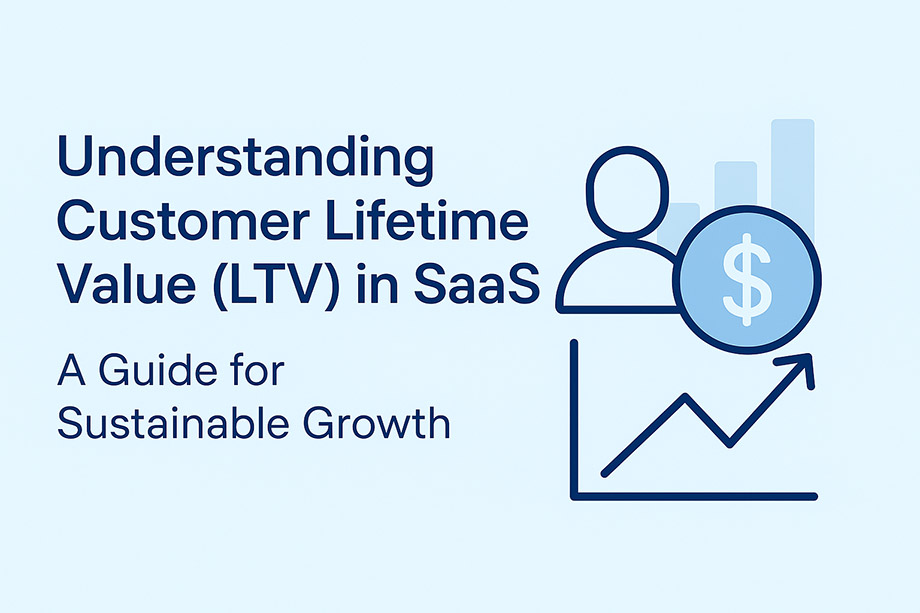Understanding Customer Lifetime Value (LTV) in SaaS – A Guide for Sustainable Growth

When you’re running a SaaS business, it’s easy to focus on short-term wins like monthly revenue, signups, or your latest campaign performance. But if you’re not thinking about how much each customer is worth in the long run, you’re missing a major piece of the growth puzzle.
That’s where Customer Lifetime Value, or LTV, comes in. It’s not just another metric. It’s the backbone of sustainable decision-making in SaaS.
Let’s break it down step by step.
What Is Customer Lifetime Value?
Customer Lifetime Value is the total revenue you can expect from a customer over the entire period they use your product.
For SaaS companies, where customers pay on a recurring basis, LTV gives you a long-term view. It helps answer questions like:
- How much can you spend to acquire a customer?
- Is your pricing model profitable?
- Are your retention efforts paying off?
Instead of tracking only what happens this month, LTV focuses on the full journey of each customer and how much value they bring before they churn.
How to Calculate LTV
You don’t need a finance degree to get started. The simplest formula for LTV is:
LTV = Average Monthly Revenue per Customer × Average Customer Lifespan (in months)
Let’s say your average customer pays $60 per month and stays with you for 18 months.
LTV = $60 × 18 = $1,080
That means each customer is worth about $1,080 over their time with your product.
To get more precise, calculate customer lifespan based on churn:
Average Lifespan = 1 ÷ Monthly Churn Rate
If your churn rate is 5%, the average customer stays for 20 months (1 ÷ 0.05).
Then:
LTV = $60 × 20 = $1,200
The better your retention, the longer the relationship and the higher the LTV.
Why LTV Matters in SaaS
LTV is more than a number in your dashboard. Here’s why it matters:
Smarter Customer Acquisition
If you know that each customer brings in $1,000 over their lifetime, spending $200 to acquire one makes sense. If you’re spending $700, it may not be sustainable. LTV helps set a clear limit on your acquisition costs.
Better Pricing Strategy
A low LTV might mean your product is underpriced. A high LTV shows room for upsells or improved positioning. Either way, it gives direction.
Focused Retention Efforts
Improving retention increases customer lifespan. The longer customers stay, the more value they generate. That makes onboarding, support, and engagement critical drivers of growth.
Clearer Business Forecasting
LTV helps you predict long-term revenue and cash flow, especially useful when you’re planning to raise funding or scale.
How to Increase LTV Without Just Raising Prices
Growing LTV doesn’t mean you have to charge more. It’s about helping customers get more value from your product over time.
Improve Onboarding
Help new users find success fast. Streamline your onboarding flow and guide them toward their first wins quickly.
Boost Engagement
Use reminders, tips, and check-ins to keep customers active. The more they use your product, the less likely they are to leave.
Upsell and Cross-Sell
Offer advanced features, additional tools, or team plans that increase monthly revenue without requiring a new customer.
Monitor Customer Health
Watch for signs of churn like reduced activity or skipped payments. Reach out with personalized support before they walk away.
Build Long-Term Relationships
When people feel supported and heard, they stay longer. Focus on consistent, quality interactions from onboarding to support.
LTV vs CAC: The Ratio That Drives Growth
One of the most important benchmarks in SaaS is the LTV to CAC ratio.
A healthy target is 3 to 1. That means for every dollar you spend acquiring a customer, you should earn at least three dollars back over their lifetime.
If the ratio is lower than 1 to 1, you’re losing money. If it’s higher than 5 to 1, you may be playing too safe and missing growth opportunities.
Final Thoughts
Customer Lifetime Value is more than a finance metric. It reflects how well your entire business is performing from product and support to retention and pricing.
If you’re serious about building a scalable SaaS company, start paying attention to LTV. It will guide smarter decisions, help you balance spending, and improve the overall health of your business.

